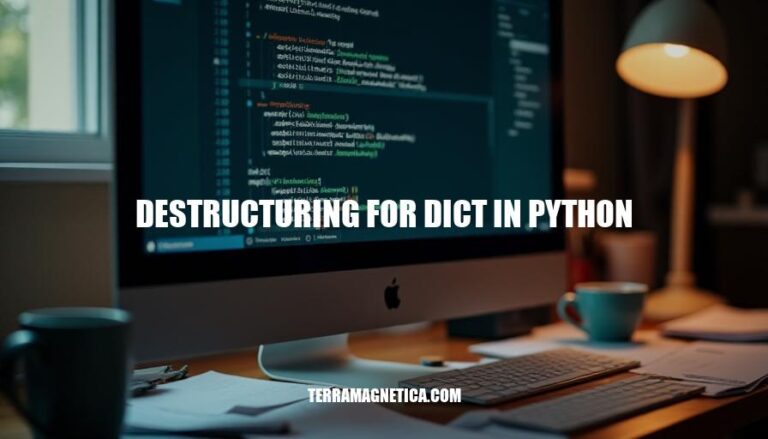


Destructuring in Python, also known as unpacking, allows you to extract values from data structures like dictionaries and assign them to variables in a single statement. This is particularly useful for improving code readability and efficiency.
For dictionaries, destructuring involves assigning the dictionary’s values to variables directly. For example:
my_dict = {"name": "Alice", "age": 30}
name, age = my_dict["name"], my_dict["age"]
This technique is important because it simplifies the process of working with complex data structures, making your code cleaner and more maintainable.
Here’s the basic syntax for destructuring dictionaries in Python, along with examples:
a_dict = {'key1': 'value1', 'key2': 'value2'}
key1, key2 = a_dict['key1'], a_dict['key2']
person = {'name': 'Alice', 'age': 30}
name, age = person['name'], person['age']
print(name) # Output: Alice
print(age) # Output: 30
items() Methodperson = {'name': 'Bob', 'age': 25}
for key, value in person.items():
print(f"{key}: {value}")
# Output:
# name: Bob
# age: 25
itemgetter from operatorfrom operator import itemgetter
person = {'name': 'Charlie', 'age': 35}
name, age = itemgetter('name', 'age')(person)
print(name) # Output: Charlie
print(age) # Output: 35
These examples show different ways to destructure dictionaries in Python, allowing you to easily extract and assign values to variables.
To use the dict.values() method for destructuring a dictionary in Python, follow these steps:
Create a dictionary:
my_dict = {'name': 'Alice', 'age': 30, 'city': 'New York'}
Use dict.values() to get the values:
values = my_dict.values()
Destructure the values into variables:
name, age, city = my_dict.values()
print(name) # Output: Alice
print(age) # Output: 30
print(city) # Output: New York
Example:
# Step-by-step example
my_dict = {'name': 'Alice', 'age': 30, 'city': 'New York'}
name, age, city = my_dict.values()
print(name) # Output: Alice
print(age) # Output: 30
print(city) # Output: New York
Make sure the number of variables matches the number of values in the dictionary to avoid errors.
The operator.itemgetter class in Python is used to extract specific items from a dictionary. Here’s how you can use it for destructuring:
from operator import itemgetter
# Example dictionary
a_dict = {'first': 'bobby', 'last': 'hadz', 'site': 'bobbyhadz.com'}
# Destructuring using itemgetter
first, last, site = itemgetter('first', 'last', 'site')(a_dict)
print(first) # Output: bobby
print(last) # Output: hadz
print(site) # Output: bobbyhadz.com
You can also extract a subset of the dictionary:
from operator import itemgetter
# Example dictionary
a_dict = {'first': 'bobby', 'last': 'hadz', 'site': 'bobbyhadz.com'}
# Destructuring a subset
first, last = itemgetter('first', 'last')(a_dict)
print(first) # Output: bobby
print(last) # Output: hadz
The itemgetter function returns a callable object that fetches the specified items from the dictionary when called.
Here are some common pitfalls and errors when using destructuring for dictionaries in Python, along with tips to avoid them:
KeyError:
.get() method with a default value.data = {'name': 'Alice'}
name = data.get('name', 'Unknown')
age = data.get('age', 0)
Unpacking Nested Dictionaries:
data = {'user': {'name': 'Alice', 'age': 30}}
user = data.get('user', {})
name = user.get('name', 'Unknown')
age = user.get('age', 0)
Overwriting Variables:
data = {'name': 'Alice'}
name = 'Bob'
name = data.get('name', name) # Keeps 'Alice' from data
TypeError with Non-Dict Objects:
data = ['Alice', 30]
if isinstance(data, dict):
name = data.get('name', 'Unknown')
Ignoring Unused Keys:
_ for unused keys.data = {'name': 'Alice', 'age': 30, 'city': 'Wonderland'}
name, _, _ = data['name'], data['age'], data['city']
Default Values for Missing Keys:
data = {'name': 'Alice'}
name = data.get('name', 'Unknown')
age = data.get('age', 0)
By being mindful of these pitfalls and using the suggested techniques, you can effectively avoid common errors when destructuring dictionaries in Python.
Here are some advanced techniques for destructuring dictionaries in Python:
You can destructure nested dictionaries by combining multiple destructuring assignments:
data = {
"name": "Alice",
"details": {
"age": 30,
"address": {
"city": "Wonderland",
"zip": "12345"
}
}
}
# Destructuring nested dictionary
name, (age, (city, zip_code)) = data["name"], data["details"]["age"], data["details"]["address"].values()
print(name) # Output: Alice
print(age) # Output: 30
print(city) # Output: Wonderland
print(zip_code) # Output: 12345
To handle missing keys, you can use the dict.get() method with a default value:
data = {
"name": "Alice",
"details": {
"age": 30
}
}
# Destructuring with handling missing keys
name = data.get("name", "Unknown")
age = data.get("details", {}).get("age", "Unknown")
city = data.get("details", {}).get("address", {}).get("city", "Unknown")
print(name) # Output: Alice
print(age) # Output: 30
print(city) # Output: Unknown
operator.itemgetterFor more complex destructuring, you can use operator.itemgetter:
from operator import itemgetter
data = {
"name": "Alice",
"details": {
"age": 30,
"address": {
"city": "Wonderland",
"zip": "12345"
}
}
}
# Using itemgetter for destructuring
name, age, city = itemgetter("name", "details.age", "details.address.city")(data)
print(name) # Output: Alice
print(age) # Output: 30
print(city) # Output: Wonderland
These techniques should help you efficiently destructure and handle dictionaries in Python!
Destructuring for dicts in Python allows you to unpack dictionary values into separate variables with a concise syntax. This technique is particularly useful when working with nested dictionaries or complex data structures. The benefits of destructuring include improved code readability, reduced boilerplate code, and increased efficiency.
Overall, destructuring for dicts in Python is a powerful technique that can improve code readability and efficiency. By mastering this technique, developers can write more concise and maintainable code.